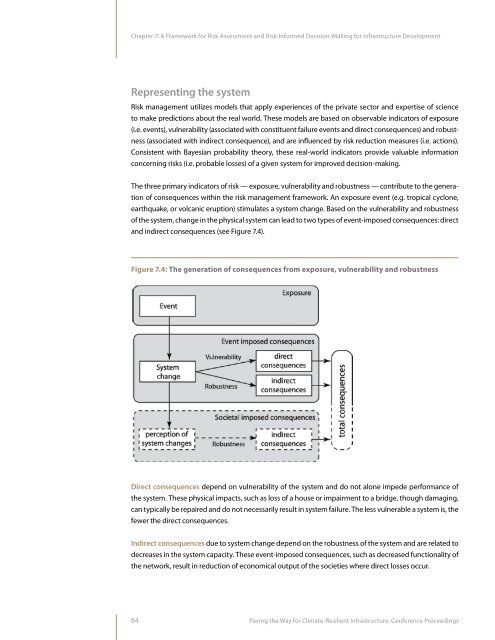Paving the Way for Climate-Resilient Infrastructure - UN CC:Learn
Paving the Way for Climate-Resilient Infrastructure - UN CC:Learn
Paving the Way for Climate-Resilient Infrastructure - UN CC:Learn
Create successful ePaper yourself
Turn your PDF publications into a flip-book with our unique Google optimized e-Paper software.
Chapter 7: A Framework <strong>for</strong> Risk Assessment and Risk-In<strong>for</strong>med Decision-Making <strong>for</strong> <strong>Infrastructure</strong> DevelopmentRepresenting <strong>the</strong> systemRisk management utilizes models that apply experiences of <strong>the</strong> private sector and expertise of scienceto make predictions about <strong>the</strong> real world. These models are based on observable indicators of exposure(i.e. events), vulnerability (associated with constituent failure events and direct consequences) and robustness(associated with indirect consequence), and are influenced by risk reduction measures (i.e. actions).Consistent with Bayesian probability <strong>the</strong>ory, <strong>the</strong>se real-world indicators provide valuable in<strong>for</strong>mationconcerning risks (i.e. probable losses) of a given system <strong>for</strong> improved decision-making.The three primary indicators of risk — exposure, vulnerability and robustness — contribute to <strong>the</strong> generationof consequences within <strong>the</strong> risk management framework. An exposure event (e.g. tropical cyclone,earthquake, or volcanic eruption) stimulates a system change. Based on <strong>the</strong> vulnerability and robustnessof <strong>the</strong> system, change in <strong>the</strong> physical system can lead to two types of event-imposed consequences: directand indirect consequences (see Figure 7.4).Figure 7.4: The generation of consequences from exposure, vulnerability and robustnessDirect consequences depend on vulnerability of <strong>the</strong> system and do not alone impede per<strong>for</strong>mance of<strong>the</strong> system. These physical impacts, such as loss of a house or impairment to a bridge, though damaging,can typically be repaired and do not necessarily result in system failure. The less vulnerable a system is, <strong>the</strong>fewer <strong>the</strong> direct consequences.Indirect consequences due to system change depend on <strong>the</strong> robustness of <strong>the</strong> system and are related todecreases in <strong>the</strong> system capacity. These event-imposed consequences, such as decreased functionality of<strong>the</strong> network, result in reduction of economical output of <strong>the</strong> societies where direct losses occur.84<strong>Paving</strong> <strong>the</strong> <strong>Way</strong> <strong>for</strong> <strong>Climate</strong>-<strong>Resilient</strong> <strong>Infrastructure</strong>: Conference Proceedings
















